TravelMag.com asked 300 writers, photographers and selected travel professionals with a love for all things Irish, to name the three towns in Ireland that they consider to be the most charming. Here are the 20 towns in Ireland that accumulated the most votes.
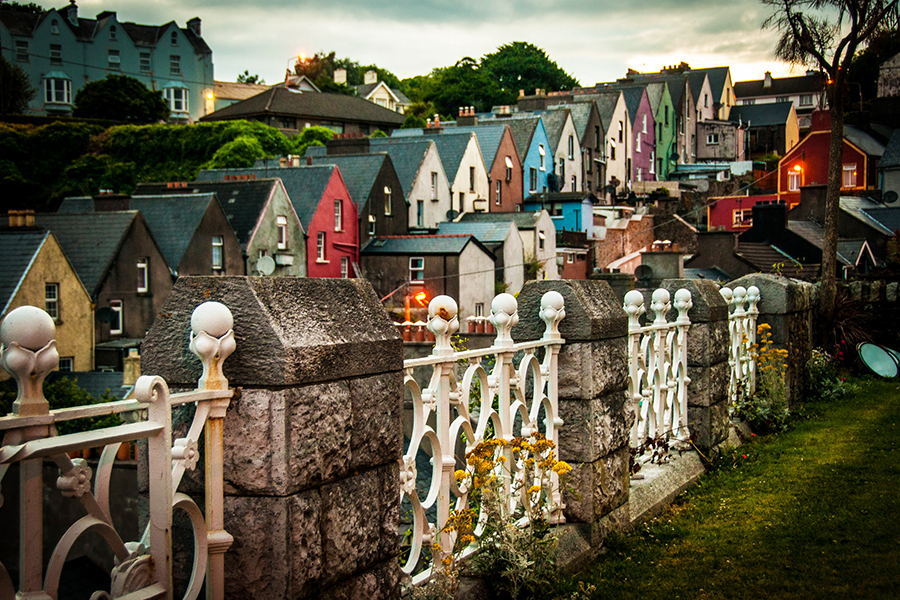
Quirky Cobh (Photo: Michelle O’Riordan via Flickr / CC BY 2.0)
Travel in the Emerald Isle can be measured by the succession of personal interactions. It’s impossible to visit and not be won over completely by the genuine warmth of an Irish welcome. Unsurprisingly, the charm of towns in Ireland is evident not just in the people but everywhere from the streets to the pubs. But what are some of the best small towns in Ireland to visit?
When you mention Ireland and travel in the same sentence, most folk usually think about the classics of Cork or Dublin. Perhaps it evokes a poetic idyll of Galway through a verse of Galway Bay, as sung by Liam Clancy, for the more discerning individual. But for the real hibernophiles (fans of Irish culture) out there, smaller towns may come to mind, with pleasant cottages and passionate communities.
TravelMag.com surveyed the people in the know to find out which are the best towns in Ireland. Towns of all sizes were considered for this survey, only excluding Ireland’s main five cities (Dublin, Galway, Cork, Waterford and Limerick). Similarly, we did not include any villages. Below you will find the 20 Irish towns that accumulated the most votes, from A to Z (well, technically W).
Adare
It may kick off proceedings by virtue of the alphabet, but Adare is more than worthy of this list. The beautiful thatched cottages and historic buildings are part of what makes this one of Ireland’s prettiest towns. There are also plenty of historical landmarks in Adare. It is possible to explore the ramparts of Desmond Castle, dating back to the 12th century, meanwhile Adare Manor has been converted into a luxury hotel and golf resort. Next to the golf course are the ruins of a 15th century Franciscan Abbey. An alternative Catholic order, the Trinitarians, have their own, still operational monastery in town.

Adare Manor (Photo: Michael Costa via Flickr / CC BY 2.0)
Ardara
An unassuming coastal town in County Donegal, Ardara (pronounced ‘Ardra’) is a great place to experience a gentler pace of life in Ireland. The rural surrounds, from the rugged coastline to the moorland passes are what bring most people to this less visited corner of the country. The town is pleasant and a good base from which to visit the Maghera Falls or get great views out over the Atlantic Ocean from Loughros Point. The Kilclooney Dolmen tombs close by date back 3500 years and are one of the few Celtic monuments that you won’t have to share with droves of other tourists.

Ardara town centre (Photo: via Wikicommons)
Aughrim
Ireland has a couple of towns by the name of Aughrim, but it’s this scenic one in County Wicklow that makes the list. Located by the confluence of the Derry and Ow rivers, the town’s original raison d’être was the nearby granite mine. As such the terraced houses, town hall and forge are all constructed of granite and have a unique architectural style. Hikers are especially drawn to the town as it is a great starting point for the pleasant Sean Linehan Walk, a 6km route that starts at Tinakilly Bridge in Aughrim.

Aughrim Forge in the town centre (Photo: via Wikicommons)
Birr
Ireland’s interior is often overlooked or simply bypassed for larger towns and cities, but Birr makes a good claim for taking a break here. Known as a heritage town, its jaunty character is provided by the well-preserved Georgian buildings, many of which are painted different colours. Among the many sites of interest in town, Birr Castle is the most intriguing. While the castle itself is a comely building, the astronomy, which the occupying Earls of Rosse undertook in its grounds, is the legacy that underpins the castle’s significance. A telescope built here and on show to the public was the largest in the world for 70 years until 1917, and was instrumental in a number of important advances in the science of astronomy.

Birr Castle (Photo: via Wikicommons)
Bruff
Perhaps the most wayward claim to fame for Bruff in County Limerick is that John F. Kennedy is a descendant of the Fitzgeralds of Bruff. In fact, he visited the small town in 1963. Other than that, Bruff is known more for its sporting heritage than its tourist sights. Indeed sport has become a passive attraction thanks to a number of excellent murals painted around town, such as the one of Irish rugby union hall of famer Keith Wood. Lough Gur, just to the north of Bruff, is a beautiful lake with plenty of wildlife, a heritage centre and its very own ancient stone circle.

Mural of Keith Wood on the wall of Clancy’s pub in Bruff (Photo: Kman999 via Flickr / CC BY 2.0)
Carlingford
Stand on the shore of Carlingford and look across the lough and you will see Northern Ireland. A lot of history linked to the other side of the Irish Sea can be found in the medieval streets of Carlingford. An old toll gate and mint are overshadowed however by the impressive King John Castle that was built around 1210 by the Normans after they first invaded Ireland in 1173. The town’s strategic location has ever been its source of success and strife. But divisions aside, the town is packed with historic remnants and you can find some excellent seafood here too.
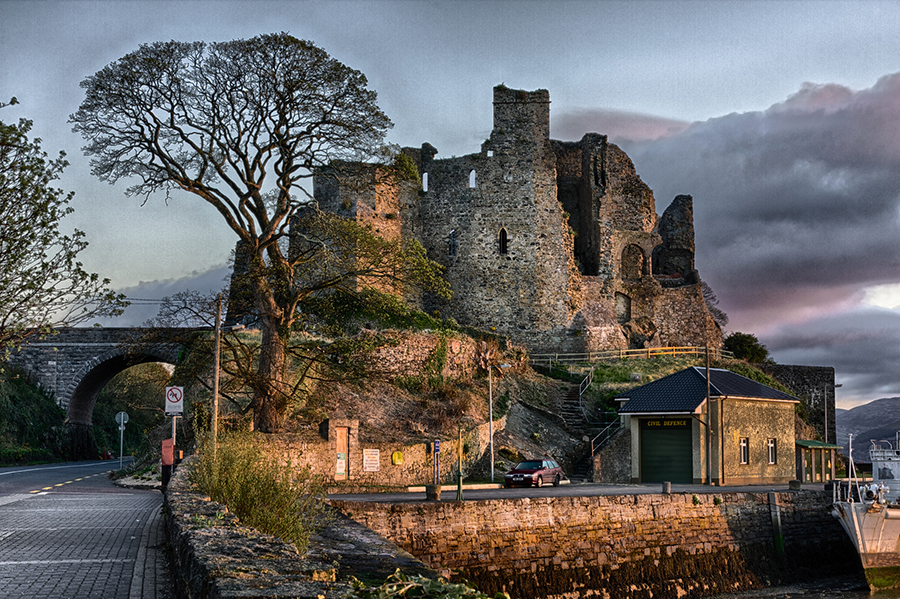
St John’s castle in Carlingford (Photo: Richard Browne via Flickr / CC BY 2.0)
Clifden
County Galway is widely regarded as one of the prettiest Irish counties, and Clifden’s verdant, wooded surrounds do nothing to diminish that claim. Starting life relatively late, in the early 19th century, Clifden came into being thanks to Clifden Castle close by. The town was connected by a road to Galway and beyond. While the estate failed and fell into disrepair, the town continued its modest growth and is regarded as the unofficial capital of Connemara today. The pretty town centre may attract many visitors alone, but it’s the surrounding countryside that lends Clifden its popularity. Connemara National Park, the Twelve Bens mountain range and Inishbofin Island are all popular places close by.

Pleasant Clifden surrounded by the mountains and nature of Connemara (Photo: martina mcauley via Flickr / CC BY 2.0)
Cobh
Making its name as an important sea port for transatlantic ships, Cobh was the last stopping point in Europe before the Titanic began its fateful maiden voyage. The town is quaint and quirky. Cute little painted cottages step down to the waterfront beside the prominent spire of St. Colman’s Cathedral. There is a memorial by the water’s edge to the Lusitania, another notable ship that succumbed to the deeps after being sunk by a German U-boat close by. Cobh was an important port in some of the most significant mass migrations of people in the 19th century, including millions of Irish emigrants who departed from the port here on their way to North America, and more ignominiously, the many thousands of prisoners deported to penal colonies such as Australia.
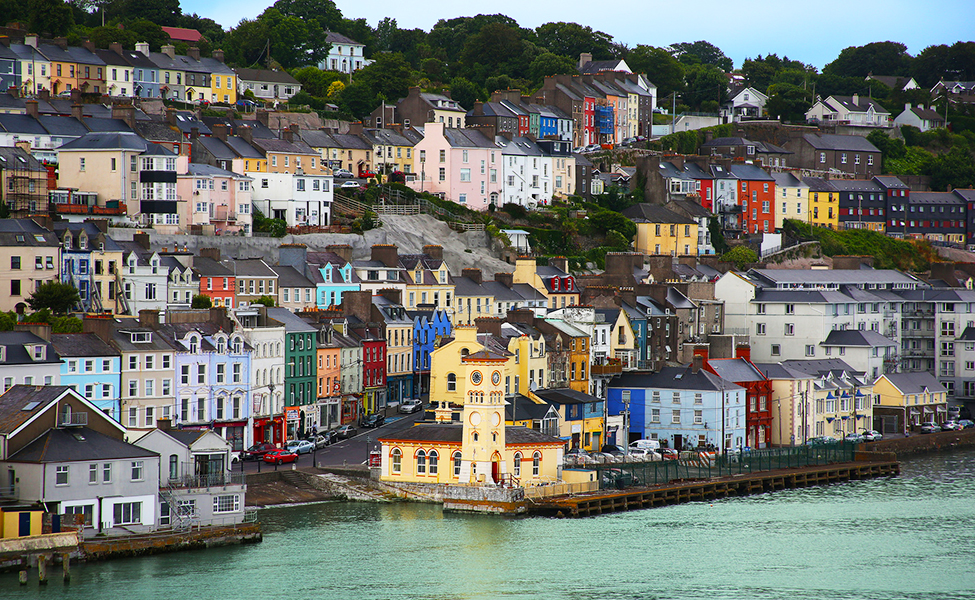
Cobh’s colourful waterfront houses (Photo: Rennett Stowe via Flickr / CC BY 2.0)
Dalkey
Vikings and plagues are two of the things that brought Dalkey a large share of notoriety in days gone by. The plague likely entered Ireland through a ship docking at the port, which was first constructed by Viking invaders in the 8th century. Now the names associated with the town, located just to the south of Dublin, include the likes of Bono, Enya and Van Morrison. The town is considered an affluent satellite of the Irish capital city. But with castles, restaurants and bars of its own, it enjoys the atmosphere of a pleasant historical town, far removed from that of a busy city.
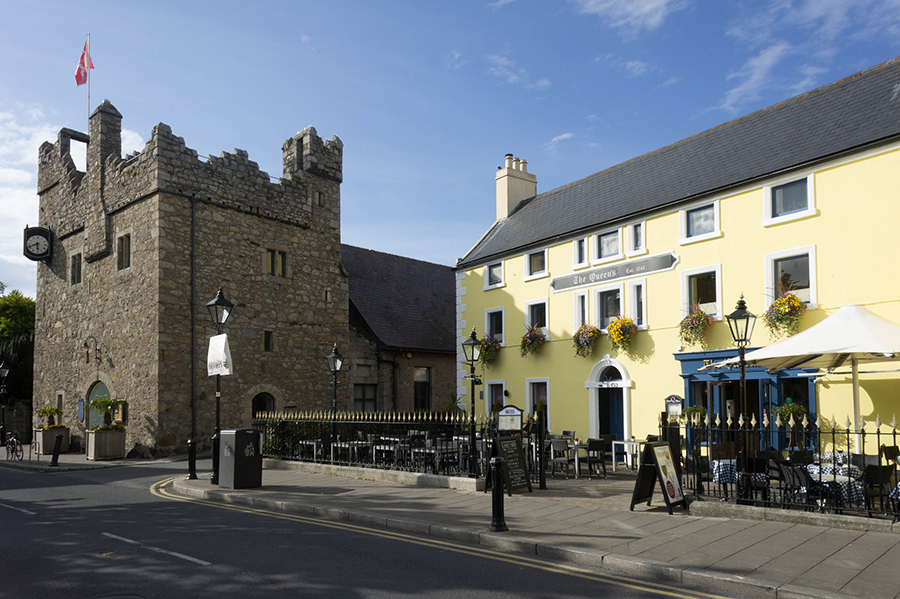
Castle Street in Dalkey (Photo: William Murphy via Flickr / CC BY 2.0)
Dingle
The key town on the Dingle Peninsula is a pleasant fishing harbour at one end of the rugged Conor Pass, which winds over the mountainous finger of land offering some of Ireland’s most captivating views. The area is well known for its Irish culture, and Gaelic is heard as often as English. The pubs are the centre of the cultural action, at least where music is concerned. Meanwhile the sea life of the area is another popular draw, with bottlenose dolphins regularly spotted in the bay and an aquarium in town allowing visitors to learn more about the world beneath the waves.

Dingle Harbour with the mountains rising up behind (Photo: Steve Edge via Flickr / CC BY 2.0)
Donegal
As the namesake of County Donegal, culture and sport find their regional hub in Donegal Town. There are plenty of smaller amateur clubs for sports like Gaelic football and hurling, but even at amateur level Gaelic sports showcase a remarkable level of physical prowess and power. The town’s early history predates written records, and is instead written in the stone circle formations that are common in this part of Ireland. Donegal Castle is in the town centre and it is near this centrepiece that many of the hotels and pubs can be found. Donegal Town is a great base for hikers looking to tackle the Blue Stack Mountains.
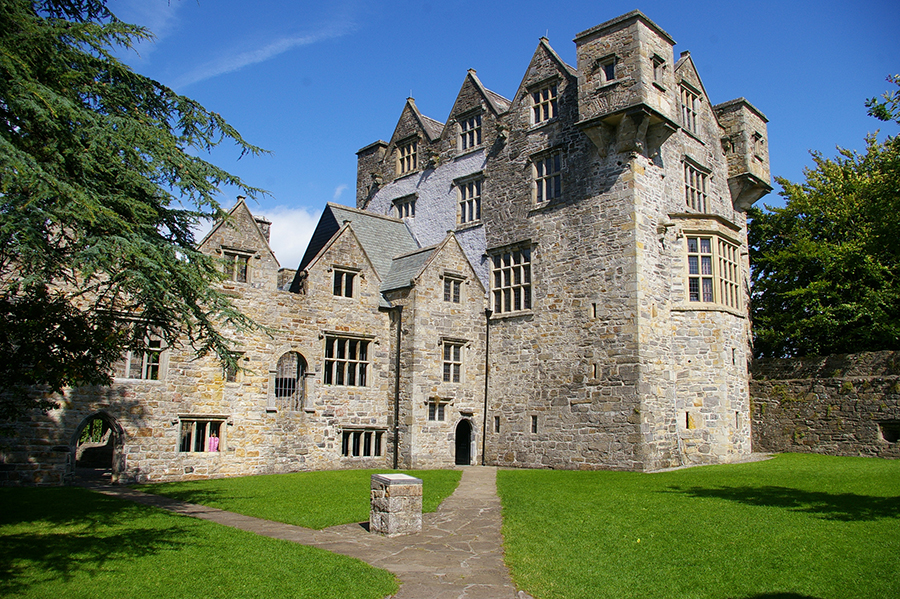
Donegal Castle (Photo: Hec Tate via Flickr / CC BY 2.0)
Dungarvan
As a small harbour town midway along Ireland’s southern coast, Dungarvan has managed to retain much of its traditional Irish charm. The town is actually split in two by the Colligan River’s estuary, with the main sights of the town found on the west side of the river. These include the Waterford County Museum and, as with so many Irish towns, its own castle. Dungarvan Castle overlooks the harbour, which is mainly populated by small sailing and fishing boats today. There is also the remnant of an old Augustinian friary, around which has been built a more modern Catholic Church.

Ivy covered houses in Dungarvan (Photo: Sebastian via Flickr / CC BY 2.0)
Kenmare
Situated at the head of Kenmare Bay, which gradually opens out into the wide Atlantic Ocean, Kenmare is a typically charming County Kerry town. The town first gained some semblance of international prominence through its lace-working industry. The excellence in needlepoint lace technique was initiated by the nuns of Saint Clare’s Convent, although this has since closed. However the Kenmare Lace and Design Centre is open to the public. Kenmare also has its own Bronze Age stone circle and dolmen close to the town centre. Although the main centre is rather small, set in a triangle of interconnecting roads, there is an excellent selection of hotels, restaurants and pubs here.

Lovely painted houses in central Kenmare (Photo: adrivdm via Flickr / CC BY 2.0)
Kilkenny
South Park fans may be forgiven for thinking this has a different meaning, however Kilkenny is one of Ireland’s most popular tourist destinations. Easily accessible on a day trip from Dublin, this medieval town has a number of ancient buildings in a state of excellent preservation. Kilkenny Castle is one such example, nestled on the banks of Nore River and with ample, well-tended grounds. Other notable buildings include Rothe House, a 16th century merchant’s house, and St. Canice’s Cathedral. The present day building dates back to the 13th century, but is on the site of a much older religious building. Kilkenny is more than just a historic honeypot though; the Kilkenny Arts Festival showcases Irish and international creativity over ten days every August.

River Nore and Kilkenny Castle (Photo: Stefan Jürgensen via Flickr / CC BY 2.0)
Killarney
Killarney is easily one of the prettiest and most charming places in all of Ireland. The town is a characterful attraction in its own right, with its longstanding importance as a religious site dating back to the 7th century, but Killarney National Park and Lough Leane are the most remarkable aspect of this region. Fronting Killarney town is the demesne of Ross Castle. Its walls and sturdy keep look out over the lake, which is dotted with islands and surrounded by woods through which run miles of paths. Killarney is a great place to watch some of the Gaelic sports, with a hurling team and three Gaelic football squads in town.

Ross Castle from Killarney National Park (Photo: Jandro Piriz via Flickr / CC BY 2.0)
Kinsale
Buildings in many Irish towns are daubed in colourful paints, but none as pleasantly as the small fishing town of Kinsale, located to the south of Cork. At one time the town became a prominent Royal Navy port and store houses were built in town. One of them, the James O’Neill building, can still be seen. But the town’s history is rooted in rebellion rather than subservience. The final Spanish Armada landed at Kinsale and united with Irish rebels, only to be put down. James Fort, now in ruins, was built in that battle’s wake. The narrow streets of the old town centre are great for an after dinner stroll. Unsurprisingly for a fishing town, plenty of good, fresh seafood can be sourced in Kinsale.

Bright colours in Kinsale (Photo: Sean Rowe via Flickr / CC BY 2.0)
Lismore
Lismore Abbey was once one of Ireland’s most important ecclesiastical centres for study and education. While the abbey was short lived, soon to be replaced by Lismore Castle, which still stands, the scholastic importance remained. In the 15th century the Book of Lismore was compiled of various writings including folios on Irish saints, including Saint Patrick, and some Irish mythology too. More recently, writers such as William M. Thackeray, who stayed at Lismore House Hotel and travel writer Dervla Murphy, who was born in Lismore, continue the town’s literary tradition.

Lismore Castle (Photo: via Wikicommons)
Malahide
Only 40 minutes north of Dublin is one of Ireland’s most charming fishing towns. Malahide has, like so many Irish towns, a castle and demesne that are considered enough of a draw to the region in their own right. However it is the large marina that is Malahide’s most endearing feature. The town has a small beach, and across the estuary are no fewer than four different golf clubs. For outdoorsy types there is a pleasant coastal walk to Portmarnock from Malahide, where a much larger beach can be found. Although many people see Malahide as a good day trip from Dublin, there are a few hotels in town for those who prefer to stay away from the hustle and bustle of a big city.

Malahide harbour at low tide (Photo: Miguel Mendez via Flickr / CC BY 2.0)
Oughterard
This charming town, located in County Galway, is surrounded by loughs on one side and hills on the other. Oughterard is well known as an angling centre, with Lough Corrib, the largest lake in the Republic of Ireland, being an excellent source of fish. The town itself is peaceful and is usually considered an excellent place to stay when looking to explore the surrounding countryside. Outside of town are a couple of castles, the best known of which is Aughnanure, an impressive structure dating back to the 16th century. The Glengowla Quartz mines are also close by.

Aughnanure Castle near Oughterard (Photo: Dan Merino via Flickr / CC BY 2.0)
Westport
Westport’s defining feature are the malls either side of the Carrowbeg River running through the heart of town. The Georgian buildings and design of the town were the work of renowned British architect James Wyatt who is known for designing a number of buildings, including the Royal Military Academy in Woolwich. The town is considered to be one of the best in Ireland, both in terms or its charm and its quality of life. One of the main draws of Westport is the nearby scenery, which includes Croagh Patrick, a mountain to which many people make a pilgrimage each year for the summer solstice.

Westport Co. Mayo (Photo: Emily Jackson via Flickr / CC BY 2.0)